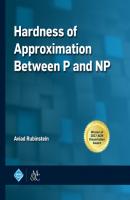Hardness of Approximation Between P and NP. Aviad Rubinstein
Чтение книги онлайн.

Читать онлайн книгу Hardness of Approximation Between P and NP - Aviad Rubinstein страница 19
Название: Hardness of Approximation Between P and NP
Автор: Aviad Rubinstein
Издательство: Ingram
Жанр: Программы
Серия: ACM Books
isbn: 9781947487222
isbn:
The idea is to replace a single player—Alice—who chooses x in the ϵ-grid of [−1, 2]Θ(n) by a population of Θ(n) players
Now, we replace the guess of v ∈ {0,1}Θ(n), which is done by Bob, by population of size Θ (n) where again each player is responsible to a single coordinate of v. Again, in a WSNE all players will guess correctly.
Similarly for the guess of β: we think of β ∈ [M]3 as an element of [0,1}3logM and we construct a population of 3 log M players; each controls a single bit.
Similarly for Alice’s guesses of IA(v) and IA(v): we construct 6 players, and each chooses a bit.
Finally, we again replace the choice of y ∈ [−1, 2]Θ(n) by a population of Θ(n) players
n-Player Game: (ϵ, ϵ)-Weak ANE and Binary Actions
In the above reduction, the x-type (and y-type) players have 3/ϵ actions each. To construct a binary action game, we use the technique of Babichenko [2016]. We replace each such player by a population of 3/ϵ players, each located at a point in the ϵ-grid of the segment [−1, 2]. A player that is located at j ∈ [−1,2](on the ϵ-grid) has to choose between the two points j or j + ϵ. In a WSNE, all players located to the left of yi will choose j + ϵ, and all players located to the right of yi will choose j.
More tricky is to generalize this reduction to weak approximate equilibria. Recall that in weak approximate equilibria, a constant fraction of players may play an arbitrary suboptimal action. Here we take into account both;
1. Players that are not ϵ-best replying, and
2. Players that are ϵ-best replying, but put small positive weight on the inferior action (among the two) and the realization of their mixed action turns out to be the inferior action.
In order to be immune from this small constant fraction of irrational players, we use error-correcting codes.5 Let Eβ:{0,1}3 log M → {0,1}Θ(3 log M) be a good binary error-correcting code. Instead of having a population of size 3 log M that tries to guess β, we replace it by a population of size Θ(3 log M) where each player tries to guess his bit in the encoding of β. Now even if a small constant fraction of players will act irrationally, the decoding of the action profile of the β-type players will turn out to be ß. We use the same idea for all types of populations (x-type, y-type, v-type, and I-type). This idea completes the reduction for weak approximate equilibria.
3.5 Proofs
In Subsection 3.5.1 we prove a randomized query lower bound for the end-of-the-line problem. In Subsection 3.5.2 we show how the lower bounds of Subsection 3.5.1 can be “lifted” to get a hard problem in the randomized communication complexity models. In Subsections 3.5.3, 3.5.4, and 3.5.5 we reduce the communicationally hard end-of-any-line problem to the approximate Nash equilibrium problem.
3.5.1 A Randomized Query Complexity Lower Bound
Let G be a directed graph with the vertices V = {0, 1}n ×{0, 1}n × [n + 1]. Each vertex (v1, v2, k), where v1, v2 ∈ {0, 1}n and k ∈ [n], has two outgoing edges to the vertices
We define the QUERY END-OF-THE-LINE to be the problem of finding the end of a line in G that starts at the point 02n+1. More formally, we represent a line in G by a triple I(v) ≜ (T(v), S(v), P(v)) where T(v) ∈ {0, 1} indicates whether the line goes through v, S(v) ϵ {0, 1} indicates who is the successor of v, and P(v) ∈ {0, 1} indicates who is the predecessor of v (here we use the fact that each vertex has outgoing and incoming degree of at most two). Throughout the chapter, we slightly abuse notation and use S(v)/P(v) to refer both to the bits and to the corresponding vertices (i.e., the S(v)/P(v)-successor/predecessor of v). The end of the line is the vertex v* such that T(v*) = 1 but T(S(v*)) = 0.
Definition 3.1
QUERY END-OF-THE-LINE.
Input: A line I = (T, S, P) over the graph G that starts at the point 02n+1.
Output: The first bit ([v*]1) of the end-of-the-line СКАЧАТЬ